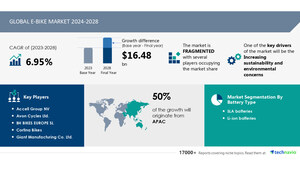NEW YORK, Nov. 12, 2024 /PRNewswire/ -- Report on how AI is driving market transformation - The global insulation market size is estimated to grow by USD 24.3 billion from 2024-2028, according to Technavio. The market is estimated to grow at a CAGR of 5.6% during the forecast period. Growing need for energy efficiency in buildings is driving market growth, with a trend towards green building developments influencing sales prospects. However, lack of skilled workforce poses a challenge.Key market players include Aeroflex USA Inc., Altana AG, Armacell International SA, BASF SE, Carlisle SynTec Systems, Compagnie de Saint Gobain, Continental AG, Dow Inc., Holcim Ltd., Huntsman Corp., Kaneka Corp., Kingspan Group Plc, Knauf Digital GmbH, Owens Corning, Recticel Group, Rilmac Group of Companies, ROCKWOOL International AS, Synthos SA, Thermaflex, and Xella International GmbH.
Key insights into market evolution with AI-powered analysis. Explore trends, segmentation, and growth drivers- View Free Sample PDF
Insulation Market Scope |
|
Report Coverage |
Details |
Base year |
2023 |
Historic period |
2018 - 2022 |
Forecast period |
2024-2028 |
Growth momentum & CAGR |
Accelerate at a CAGR of 5.6% |
Market growth 2024-2028 |
USD 24.3 billion |
Market structure |
Fragmented |
YoY growth 2022-2023 (%) |
5.15 |
Regional analysis |
APAC, North America, Europe, Middle East and Africa, and South America |
Performing market contribution |
APAC at 47% |
Key countries |
China, US, Japan, Germany, and UK |
Key companies profiled |
Aeroflex USA Inc., Altana AG, Armacell International SA, BASF SE, Carlisle SynTec Systems, Compagnie de Saint Gobain, Continental AG, Dow Inc., Holcim Ltd., Huntsman Corp., Kaneka Corp., Kingspan Group Plc, Knauf Digital GmbH, Owens Corning, Recticel Group, Rilmac Group of Companies, ROCKWOOL International AS, Synthos SA, Thermaflex, and Xella International GmbH |
Market Driver
The insulation market is experiencing significant growth due to increasing customer spending on energy conservation and awareness. Key trends include the use of advanced materials like Aerogel and ceramic fibers in various sectors such as aerospace, marine, and industrial buildings. Building codes are becoming stricter, driving demand for efficient insulation materials like EPS (Expanded Polystyrene) and mineral wool. Domestic players are focusing on product penetration and technological enhancements to meet the growing demand. Energy-efficient innovation is a priority, with a shift towards environmentally friendly materials like recyclable plastics and wool-derived insulation. Fire resistance and impact resistance are crucial factors in high-rise residential structures and non-residential buildings. Industrial areas and infrastructure spending are also driving demand for insulation materials in factories, refineries, and petrochemical industries. The oil & gas industry is investing in energy consumption reduction through the use of insulation in pipelines and storage tanks. Acoustic insulation is another growing area, particularly in auditoriums, movie theaters, and other public buildings. Regulations and environmental concerns are pushing the use of sustainable construction practices and materials like lime, silica, and wood fiber. The market is also witnessing capacity expansion by key players like Element Materials Technology to meet the growing demand. Technological advancements like vacuum insulation panels and transparent weather tape are improving insulation properties and reducing thermal heat gain and loss.
The building and construction sectors consume a significant amount of energy and natural resources, with insulation materials being a major contributor. Green building, an approach that prioritizes energy sustainability and resource conservation, is increasingly popular. Green building materials, such as those derived from sustainable resources, play a crucial role in this movement. However, the manufacturing process for building materials accounts for approximately 40% of industrial emissions, including black carbon. With the projected increase in institutional and commercial structures by 2050, it is essential to prioritize the use of eco-friendly insulation solutions to reduce environmental impact.
Request Sample of our comprehensive report now to stay ahead in the AI-driven market evolution!
Market Challenges
- The insulation market is experiencing significant growth due to increasing energy consumption and the need for energy conservation. Challenges in this industry include the use of new materials like Aerogel and ceramic fibers in aerospace, marine, and industrial sectors. Building codes and environmental regulations require the use of environmentally friendly materials, such as recyclable ones, in residential and non-residential structures. Domestic players face competition from international players, and distribution networks play a crucial role in product penetration. Insulation materials like EPS (Expanded Polystyrene), fiberglass, and mineral wool continue to dominate the market. New innovations, such as vacuum insulation panels and transparent weather tape, offer energy efficiency and acoustic insulation benefits. Industries like oil & gas, petrochemical, and refineries require high-performance insulation materials for operating temperature resistance and fire safety. Homeowners and builders prioritize energy-efficient insulation for homes and high-rise residential structures, with R-value and fire resistance being key considerations. Technological enhancements, such as removable blankets and reinforcing fibers, offer improved insulation properties and impact resistance. Sustainable construction and energy conservation awareness are driving the demand for efficient materials, including lime, silica, and wood fiber-derived insulation materials. The market is expected to grow further due to infrastructure spending, capacity expansion, and the need for energy consumption reduction in various industries.
- The global insulation market faces a significant challenge due to the shortage of skilled labor. Professionally trained workers with expertise in insulation materials and installation techniques are in high demand. The insulation process for buildings is a complex task, involving the selection of suitable materials based on factors such as building dimensions, nature, external environment, and thermal retention properties. Temperature plays a crucial role in determining the appropriate insulation material. Vendors in the insulation industry are grappling with this issue, as the lack of technically proficient employees hinders market growth.
Discover how AI is revolutionizing market trends- Get your access now!
Segment Overview
This insulation market report extensively covers market segmentation by
- Product
- 1.1 Wool
- 1.2 Plastic foam
- 1.3 Others
- End-user
- 2.1 Non-residential
- 2.2 Residential
- Geography
- 3.1 APAC
- 3.2 North America
- 3.3 Europe
- 3.4 Middle East and Africa
- 3.5 South America
1.1 Wool- The insulation market is experiencing significant growth due to the increasing demand for eco-friendly insulation solutions and the rapid pace of urbanization and construction activities. Mineral wool, a fibrous and flexible material manufactured from rock or mineral materials, is a popular choice for insulation due to its effective heat and sound insulation properties. In the construction industry, mineral wool is widely used in walls and ceilings to improve sound insulation. Vendors are innovating to deliver more thermally efficient wool insulation products, such as ROCKWOOL's NyRock technology, which offers the lowest lambda stone wool insulation in the UK. Additionally, vendors are focusing on the environmental impact of wool insulation products by providing Environmental Product Declarations (EPDs) and Green Building Rating Systems (GBRS) download centers, which help specifiers earn points in popular GBRS like BREEAM, LEEDv4, DGNB, and WELL. These factors are expected to positively impact the wool insulation segment in the global insulation market during the forecast period.
Download a Sample of our comprehensive report today to discover how AI-driven innovations are reshaping competitive dynamics
Research Analysis
The insulation market is experiencing significant growth due to increasing focus on energy conservation and regulatory compliance. Infrastructure spending on construction projects, stay-at-home instructions, and social distancing mandates have accelerated the demand for thermal insulation materials, including glass wool and mineral wool. Environmental regulations are driving the market towards eco-friendly insulation solutions. Heat loss and electricity consumption are major concerns, making insulation essential for both residential and industrial applications. Insulation materials are used not only for heat but also for electrical and acoustic insulation. Building materials companies are innovating to provide high-quality insulation materials for construction projects, cold storage units, and refrigerated warehouses. Transparent weather tape is a recent addition to the market, offering both insulation and sealing properties.
Market Research Overview
The insulation market encompasses a wide range of applications and industries, driven by the need for energy conservation, efficiency, and environmental regulations. Insulating materials, such as Aerogel, ceramic fibers, fiberglass, mineral wool, and wood fiber, are used in various sectors including aerospace, buildings, and industrial applications. Building codes and regulations play a significant role in driving demand for efficient materials, with a focus on fire resistance, impact resistance, and thermal insulation properties. Key applications include homes, high-rise residential structures, and non-residential structures, as well as industrial areas and infrastructure projects. The market is influenced by factors such as customer spending, distribution networks, and product penetration. Technological enhancements, including vacuum insulation panels and energy-efficient innovation, are driving growth in the market. Additionally, sustainable construction and the use of recyclable materials are becoming increasingly important, with a focus on reducing energy consumption and carbon emissions. The market includes various types of insulation materials, such as EPS (Expanded Polystyrene) insulation, fiberglass insulation, mineral wools, and plastic foams. These materials are used in various industries, including the oil & gas industry, refineries, and the marine sector. The market is also influenced by political uncertainty and regulations, with a focus on using environmentally friendly materials and reducing energy consumption. In the construction industry, insulation materials are used to reduce heat gain and heat loss, as well as to improve acoustic insulation and fire resistance. In the appliance industry, electrical insulation materials are used to improve the efficiency and safety of electrical appliances. In the aerospace sector, insulation materials are used to maintain the operating temperature of high-performance engines and protect against heat gain and heat loss. In the industrial sector, insulation materials are used to reduce cooling loads and improve energy efficiency in factories and refineries. Overall, the insulation market is a dynamic and growing industry, driven by the need for energy conservation, efficiency, and environmental regulations. With a focus on technological enhancements, sustainable materials, and customer relationship, the market is poised for continued growth in the coming years.
Table of Contents:
1 Executive Summary
2 Market Landscape
3 Market Sizing
4 Historic Market Size
5 Five Forces Analysis
6 Market Segmentation
- Product
- Wool
- Plastic Foam
- Others
- End-user
- Non-residential
- Residential
- Geography
- APAC
- North America
- Europe
- Middle East And Africa
- South America
7 Customer Landscape
8 Geographic Landscape
9 Drivers, Challenges, and Trends
10 Company Landscape
11 Company Analysis
12 Appendix
About Technavio
Technavio is a leading global technology research and advisory company. Their research and analysis focuses on emerging market trends and provides actionable insights to help businesses identify market opportunities and develop effective strategies to optimize their market positions.
With over 500 specialized analysts, Technavio's report library consists of more than 17,000 reports and counting, covering 800 technologies, spanning across 50 countries. Their client base consists of enterprises of all sizes, including more than 100 Fortune 500 companies. This growing client base relies on Technavio's comprehensive coverage, extensive research, and actionable market insights to identify opportunities in existing and potential markets and assess their competitive positions within changing market scenarios.
Contacts
Technavio Research
Jesse Maida
Media & Marketing Executive
US: +1 844 364 1100
UK: +44 203 893 3200
Email: [email protected]
Website: www.technavio.com/
SOURCE Technavio

WANT YOUR COMPANY'S NEWS FEATURED ON PRNEWSWIRE.COM?
Newsrooms &
Influencers
Digital Media
Outlets
Journalists
Opted In




Share this article